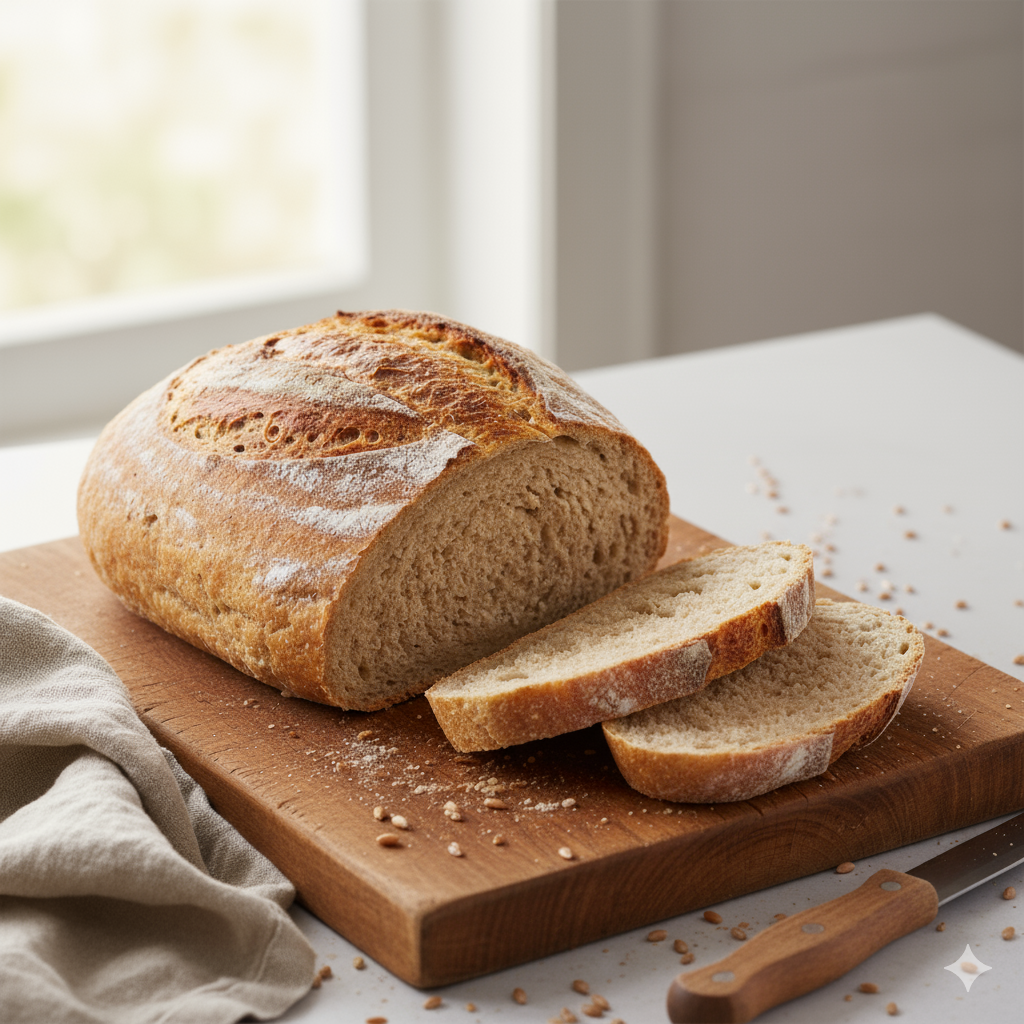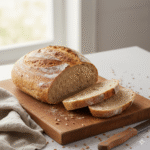Looking for a delicious whole wheat sourdough bread recipe? This recipe makes a flavorful, hearty loaf with a nutty aroma and chewy crumb. Using whole wheat adds fiber, nutrients, and a rustic texture, while still giving you that classic sourdough tang.
Jump to RecipeBaking with Whole Wheat Flour: What to Expect
Using whole wheat flour in your sourdough or bread recipe introduces a richer flavor, a nuttier aroma, and more fiber, but it can also change the texture and feel of your dough. Whole wheat flour contains the bran and germ of the wheat, which absorb more water than white flour. This means your dough may feel heavier, denser, or slightly stickier during mixing and kneading.
Because of the bran, whole wheat loaves may not rise as dramatically as those made with all-purpose or bread flour, resulting in a slightly denser crumb. However, this also gives your bread a hearty texture and a deeper flavor that many bakers love. To help your loaf stay light, you can:
- Allow for a slightly longer bulk fermentation to give the gluten time to develop.
- Consider adding a bit more hydration—about 5–10% more water than the recipe calls for in white flour—to counteract the bran’s absorbency.
- Use techniques like stretch-and-folds during proofing to strengthen the dough without overworking it.
With a little adjustment, baking with whole wheat flour can yield a loaf that’s not only nutritious but also full of character and flavor.
Whole Wheat Sourdough Bread Recipe
Equipment
- Mixing bowl
- Dough scraper or spatula
- Bench scraper (optional)
- Banneton or bowl lined with a floured kitchen towel
- Dutch oven or baking stone
Ingredients
- 350 g 2 ¾ cups whole wheat flour
- 150 g 1 ¼ cups all-purpose flour
- 375 g 1 ½ cups + 1 tbsp water, lukewarm
- 100 g ½ cup active sourdough starter
- 10 g 1 ½ tsp salt
Instructions
Autolyse
- Mix the flours and water in a bowl until no dry bits remain.
- Cover and rest for 30–60 minutes. This hydrates the flour and starts gluten development.
- Add Starter and Salt
- Mix in your active starter and salt until incorporated.
- Dough will be sticky — that’s normal for whole wheat.
Bulk Fermentation (4–6 hours)
- Perform stretch and folds every 30–60 minutes for the first 2–3 hours.
- Keep dough covered in a warm, draft-free spot (75–78°F / 24–26°C is ideal).
Shape
- Gently shape dough into a boule or batard.
- Place in a floured banneton or cloth-lined bowl.
Final Proof
- Cover and let dough rise at room temperature for 1.5–3 hours or retard in the fridge overnight for more flavor.
- Check readiness with the poke test: a slow spring-back with a slight dent means it’s ready to bake.
Bake
- Preheat oven to 475°F (245°C) with a Dutch oven inside for 30–45 minutes.
- Transfer dough into the Dutch oven, score the top, cover, and bake:
- 20–25 min covered
- 20–25 min uncovered to brown the crust
- Internal temperature should reach 205–210°F (96–99°C) for fully baked bread.
Notes
Here is a guide to help you understand the process!
| Step | Time | What to Do | Key Tips / What to Look For |
|---|---|---|---|
| Autolyse | 30–60 min | Mix flours + water, rest covered | Dough should feel hydrated, slightly shaggy |
| Mix in Starter & Salt | 10 min | Incorporate starter and salt | Dough will be sticky; use a spatula or wet hands |
| Bulk Fermentation | 4–6 hr | Stretch & fold every 30–60 min (first 2–3 hrs) | Dough should expand ~30–50%, feel airy, bubbles visible |
| Shape | 10–15 min | Gently shape into boule/batard | Handle carefully to retain gas, create surface tension |
| Final Proof | 1.5–3 hr (or overnight fridge) | Cover dough in banneton or cloth-lined bowl | Poke test: slow spring-back with slight dent = ready; retarding improves flavor |
| Preheat Oven | 30–45 min | 475°F (245°C) with Dutch oven inside | Ensure oven & pot fully hot for good oven spring |
| Bake (Covered) | 20–25 min | Score dough, bake covered | Traps steam for crust formation |
| Bake (Uncovered) | 20–25 min | Remove lid, brown crust | Crust should be deep golden; internal temp 205–210°F |
| Cool | 1–2 hr | Let loaf cool on wire rack | Necessary for crumb to set; resist cutting too early |
Final Thought
Whole wheat sourdough may take a little more attention, but the result is a deeply flavorful, wholesome loaf with a satisfying texture. Once you master hydration and timing, this recipe will become a staple in your sourdough rotation.

